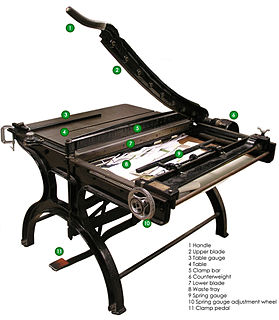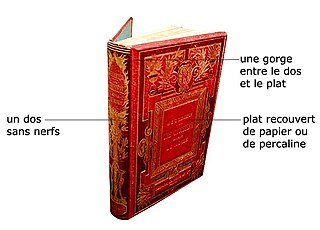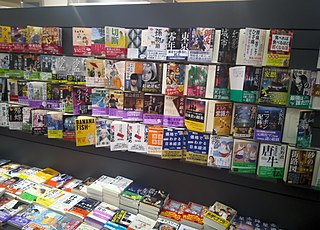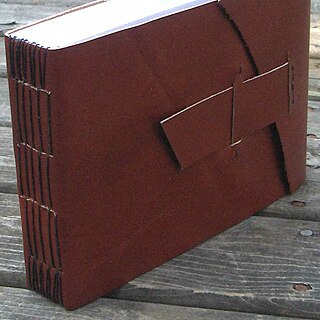 W
WBindery refers to a studio, workshop or factory where sheets of (usually) paper are fastened together to make books, but also where gold and other decorative elements are added to the exterior of books, where boxes or slipcases for books are made and where the restoration of books is carried out.
 W
WUsed extensively in bookbinding, a board shear is a large, hand-operated machine for cutting board or paper. Like scissors, a board shear uses two blades to apply shear stress exceeding the paper's shear strength in order to cut. The stationary blade forms the edge of the cutting table, with the moving blade mounted on a cutting arm. Originally known as a table gauge shear because its gauge allowed the cutting of consistently-sized materials, the board shear resembles a larger version of the paper cutters commonly found in offices.
 W
WA frontispiece in books is a decorative or informative illustration facing a book's title page—on the left-hand, or verso, page opposite the right-hand, or recto, page. In some ancient editions or in modern luxury editions the frontispiece features thematic or allegorical elements, in others is the author's portrait that appears as the frontispiece. In medieval illuminated manuscripts, a presentation miniature showing the book or text being presented was often used as a frontispiece.
 W
WBook trimming is the stage of the book production process in which the page edges of a book are trimmed so that all pages will stack with perfect edge alignment within the finished book jacket.
 W
WA Bradel binding is a style of book binding with a hollow back. It most resembles a case binding in that it has a hollow back and visible joint, but unlike a case binding, it is built up on the book. Characteristic of the binding is that the material covering the outside boards is separate from that covering the spine. Many bookbinders consider the Bradel binding to be stronger than the Case binding.
 W
WIn Japan, bunkobon (文庫本) are small-format paperback books, designed to be affordable and space saving.
 W
WCordel literature (from the Portuguese term, literatura de cordel, literally “string literature”, [koʁˈdɛw]) are popular and inexpensively printed booklets or pamphlets containing folk novels, poems and songs. They are produced and sold in street markets and by street vendors in Brazil, mainly in the Northeast. They are so named because they are hung from strings to display them to potential customers, and the word for rope in Portuguese is corda, from which the term cordel is derived.
 W
WDear Data is a collection of postcards containing data recorded from the everyday lives of information designers Stefanie Posavec and Giorgia Lupi. The book was published in the United Kingdom by Penguin Press on September 1, 2016 and in North America by Princeton Architectural Press on September 6, 2016.
 W
WDisc-binding is a type of notebook binding that uses discs to hold the sheets of paper. Each disc has a raised edge. Notebook sheets have perforations along the binding edge that match the profile and spacing of the binding discs.
 W
WAn endband is a part of a book, most often found with hardcover bindings, that consists of a small cord or strip of material affixed near the spine to provide structural reinforcement and sometimes decorative effect. An endband along the top edge of the book is called a headband, and one along the bottom edge is called a tailband.
 W
WThe endpapers or end-papers of a book are the pages that consist of a double-size sheet folded, with one half pasted against an inside cover, and the other serving as the first free page. Thus, the front endpapers precede the title page and the text, whereas the back endpapers follow the text. Booksellers sometimes refer to the front endpaper as FEP.
 W
WIn bookbinding, finishing refers to the process of decorating the outside of a book, including the lettering of the spine and covers, any additional tooling, and any inlays and onlays. Finishing can also include the gilding or other decoration of the edges of the book's pages.
 W
WThe half-title or bastard title is a page carrying nothing but the title of a book—as opposed to the title page, which also lists subtitle, author, publisher and edition. The half-title is usually counted as the first page in a printed book. The half-title can have some ornamentation of the book's title, or it can be plain text.
 W
WAn Iconophor, in graphic and print art, is a form of illustration characterized by the fact that the names of the objects represented in it start with a given letter. Its origins lie in medieval illuminations, though the abecedarian connection was usually coincidental in the Middle Ages.
 W
WIn bookbinding, inlays and onlays are pieces of leather adhered to the cover of a book, usually differing in color, grain, or both from the main covering leather. While they are complementary techniques, and may appear similar in their final forms, they are distinct in how they are constructed.
 W
WLongstitch is a bookbinding technique used for sewing together the sections of a book. There are different forms of longstitch sewings. Longstitch binding does not require glue, though there are methods that utilize glue. In his book Non Adhesive Bindings, Keith Smith describes the "Longstitch through a slotted cover" and it involves sewing each section directly through the cover where slots have been made at each sewing station. This sewing method creates a staggered line pattern visible on the spine. Keith Smith indicates that this type of longstitch was used as early as the 18th century in some parts of Europe, and possibly earlier.
 W
WA picture cover is a type of book cover which uses a method of bookbinding that preserves the contents as well as a normal hardbound book, but has the look of a paperback book. The pages are collated, stitched and trimmed as for hardbound, but a cover with a picture on it is attached instead of the normal hardbound cover with printing on the spine, and perhaps also the front. A hardbound book can achieve a similar look with a dust cover, but the cover is fragile and inconvenient when reading, being most useful while the book is shelved.
 W
WRat Catching (ISBN 0962299707) is a book by actor and filmmaker Crispin Glover. The book is a form of collage, reworked from Studies in the Art of Rat Catching, an 1896 book now in the public domain. Pictures from the book, as well as the book itself, were shown in the opening credits of the 2003 film Willard, starring Glover. The book forms a segment of Glover's live slideshow readings, performed during particular screenings of his self-produced films What Is It? and It Is Fine! Everything Is Fine..
 W
WIn bookbinding, a section, gathering, or signature is a group of sheets folded in half, to be worked into the binding as a unit.
 W
WA slipcase is a five-sided box, usually made of high-quality cardboard, into which binders, books or book sets are slipped for protection, leaving the spine exposed. Special editions of books are often slipcased for a stylish appearance when placed on a bookshelf. A few publishers, such as the Folio Society, publish all their books in slipcases.
 W
WA soft book is a type of children's book intended for pre-readers aimed primarily at babies. They are typically made of fabric, although they can also by made of soft plastic and used in the bath. They may also have an auditory component, like cellophane sheets to provide a crinkly sound. They may contain other features, like teething components, mirrors, flaps, and different textures. Soft books typically feature no or few words.
 W
WStrange Messenger is the art exhibition by Patti Smith, published in 2003 as a book.